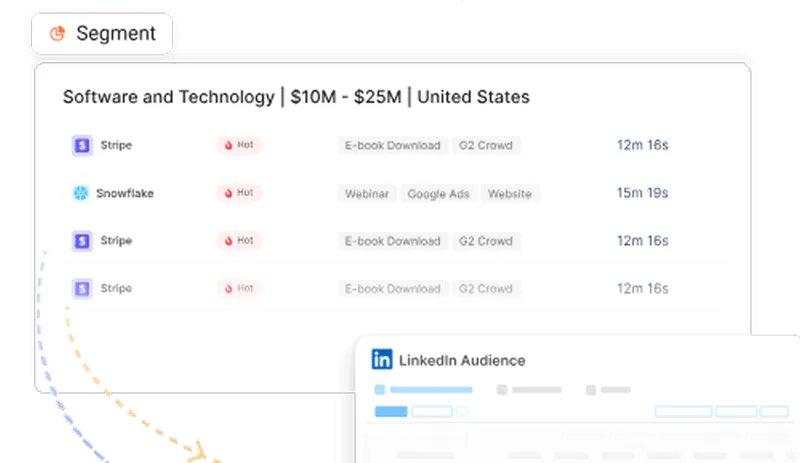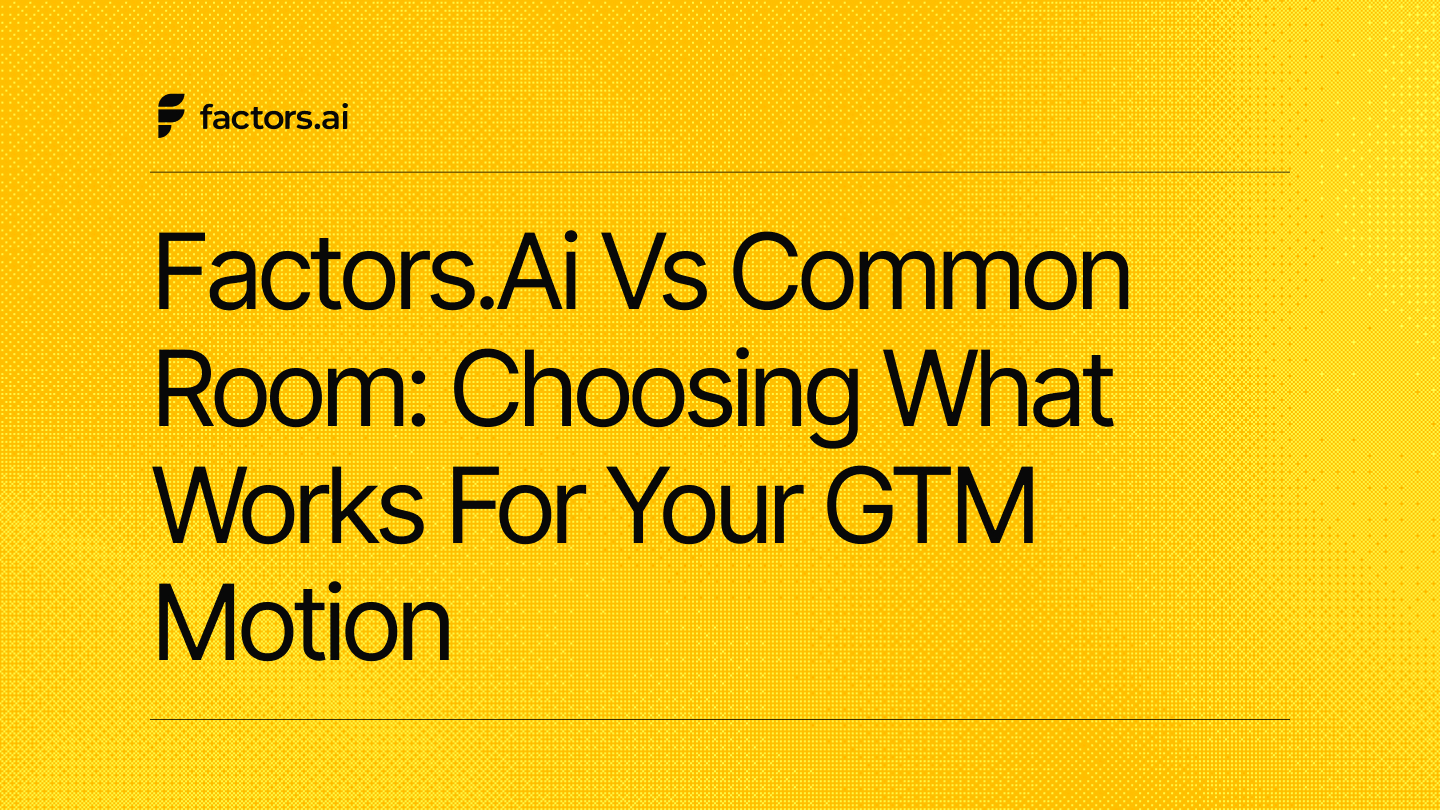The Ultimate Guide to Advanced Marketing Analytics Techniques
Unlock the power of advanced marketing analytics techniques with this guide. Learn data-driven strategies to optimize campaigns and drive business growth.
This article on advanced marketing analytics covers…
- What is advanced marketing analytics?
- Limitations with marketing analytics
- Normalization of data prior to marketing analytics
- An overview of advanced marketing analytics techniques
- How to implement the advanced marketing analytics techniques?
- How Factors can help your business?
- Frequently Asked Questions
The impact of advanced marketing analytics has consistently expanded in B2B marketing. Making sense of relevant marketing data using analytics has always been of interest to marketers, but the ability to connect large data-set across various channels and programs has taken data-driven decision making to the next level.
But how exactly can marketers go about making the most of their data? And once techniques and strategies for advanced marketing analytics have been identified, how can one ensure a smooth, frictionless implementation.
Most discussions of cutting-edge marketing and sales analytics tend to get bogged down in jargon. In this article, we will discuss the most effective methods of marketing analytics in simple terms. In order to provide a sense of how these methods operate in practice, we’ll also share a few concrete examples. Then, we'll highlight how advanced marketing analytics may be best used by data-driven marketers.
What is advanced marketing analytics?
Advanced marketing analytics is an all-encompassing term. It refers to a variety of advanced techniques and tools that teams employ to extract additional value from their data. By utilizing advanced marketing analytics, you’ll be able to predict patterns and generate accurate behavioral forecasts of your target audience and customers.
In short, advanced marketing analytics increases the value of campaigns for marketers, optimize ROI, and scale growth and pipeline.
Various types of analytics constitute advanced marketing analytics:
Regression Analytics: Regression Analytics examines the links between a dependent variable and an independent variable. This is an excellent technique for identifying trends in data, as the associations discovered in your sample will also exist in the larger population.
Predictive Analytics: Predictive analytics is a crucial component of advanced analytics, as it enables the discovery of solutions to unanswered questions. This sort of analysis employs numerous techniques from other data processes (such as data mining, AI, machine learning, and modeling) to do a comprehensive study of available data in order to make a future forecast.
Prescriptive Analytics: Business analytics culminates in prescriptive analytics. This is the method of finding the greatest potential outcome by employing technology to examine raw data and make judgments based on existing descriptive and predictive analytics.
A few limitations with basic B2B marketing analytics
In some instances, analytics may misinterpret data, leading to ill-informed decisions. This section discusses the limitations that marketing analytics can present to an organization. A few limitations are listed below:
Misidentification of marketing needs: Basic marketing analytics methods can sometimes overestimate or underestimate the market’s needs and behaviors: what do customers want, how well are competitors performing, what messaging resonates most with the audience. This, in turn, may mislead your team into making suboptimal decisions around marketing strategy.
Evaluating marketing growth in the absence of a market share: Analyzing the market should provide an idea of your potential opportunities. However, this analysis may not always be comprehensive, leading to missed opportunities that may have otherwise seemed obvious. So, in order to be sure of your data, a comprehensive market share analysis is suggested to provide sufficient context.
Improper Data Interpretation: Collecting data from multiple sources aids in data analysis, but data interpretation is an entirely separate process. If anything, interpreting data requires significantly more effort — and failing to allocate adequate resources towards this step will likely result in inaccurate conclusions.
This is where advanced marketing analytics comes into play. By utilizing advanced methods, B2B teams can help themselves achieve improved operational efficiency, increased customer satisfaction, scalable revenue, and optimized ROI.
Normalizing data prior to analysis
Before engaging in advanced analytics, the wisest investment is to thoroughly prepare the foundations of your data. Ensure that fundamental reporting requirements are met through a robust automated data and reporting pipeline, which will liberate resources, eliminate human error, and enhance data quality.
The quantity & variety of data also have an important influence. The majority of advanced analytics approaches perform substantially better with bigger volumes of granular data acquired from several sources. Remember that the results of your deployments of advanced analytics will only be as good as the data you supply.
An overview of advanced marketing analytics techniques
#1 Customer Lifetime Value
It can be an expensive error to direct marketing efforts towards the incorrect audience. Using the aforementioned conversion prediction methods, marketers can generate a list of people that are likely to convert into customers, but how do you identify the most valuable leads out of this set?
Despite their initial satisfaction, a huge number of customers never come back to a business again. A possible churn awaits those who do so. Only a small percentage of customers will remain loyal over the long term, and even fewer will go on to become true brand advocates. This underrepresented group is the most important. Especially in B2B SaaS, the Pareto principle (80/20 rule) almost always holds true: 20% of consumers generate 80% of value.
Customer lifetime value (CLV) estimates a client's future earnings using a sample of their past purchases. With this information in hand, marketers may cut costs on clients who aren't lucrative, strengthen their focus on channels that bring in similar, paying consumers, and work to reawaken the interest of previously inactive customers.
How can Factors help with CLV?
Using Timelines, Factors can generate user and account level timelines of the entire customer journey from first touch to deal won. This is especially useful to B2B SaaS organizations wherein sales cycles involve several stakeholders from the same account. The ability to visualize every touch-point based on account, roles, etc offers granular insight into what’s working for whom and in which account.

#2 Marketing Attribution
How efficient are your methods for analyzing the efficacy of marketing campaigns? How much should you be investing in each advertisement? What channels should you cut to drive ROI? These are fundamental inquiries that any successful marketing strategy must address. Due to the increasingly complex, nonlinear nature of customer journeys, marketing attribution is increasingly gaining relevance.
There are a number of ways to implement a marketing attribution strategy, and some of them entail very basic business standards, like giving all of the credit for a conversion to the very first or very last click. There are other others, though, that demand more intricate mathematical and probabilistic methods. Multi-channel attribution makes sense for firms that operate in a digital environment and analyze engagement metrics like clicks, conversions, and click pathways. Marketing Mix Modeling is a supplementary method utilized by businesses that employ conventional marketing channels (MMM). It utilizes what-if scenarios and is based on regression analysis, a well-studied statistical method. What would happen, for instance, to income if spending on television were to rise by x percent? If you already know the answers to these questions, you can use them to better allocate resources for future initiatives.
Marketing Attribution on Factors
As previously mentioned, marketing attribution is the analytical science of determining which marketing tactics are contributing to sales or conversions. Attribution models give marketers insights into how marketing dollars are best spent by showing touch points that earn the most engagements. Factors delivers a robust marketing attribution suite with a wide range of multi-touch attribution models. Want to learn more? Find a good time here.
#3 Clustering
Clustering is a valuable tool for B2B marketers. The goal is help marketers divide their target audiences into manageable subsets. This allows for better targeted content, campaigns, and offers. It is possible to generate several types or clusters of customers using heuristic rules: "Show content of type A if the customer is a millennial; show content of type B if they are gen Z."
With today’s abundence of and accessibility to large volumes of data, clustering has evolved into an effective technique to categorize a large number of clients based on any number of features or properties. These clusters emerge as a result of a statistical analysis of data using a measure of the mathematical distancing between various attributes. Customers with comparable ratings will be placed together.
Age, income, spend, duration of time since last purchase, etc. are all examples of features that can be used to segment customers. Similar success can be achieved when clustering keywords according to metrics such as organic ranking, competition level, and opportunity score. Product ads, marketing campaigns, advertisement groups, and so on can also be grouped together.

#4 Conversion prediction
Conversion prediction is not a straightforward operation because conversion rates are often in the single digits. It’s comparable to looking for a needle in a haystack. To increase your chances of success, you'll need a wealth of user behavior data from the past. Early behaviors connected to future conversion milestones can be determined based on this historical data.
Once you have identified people whose actions indicate a high possibility of conversion, you may prioritize and target them appropriately. In addition, this method is effective in identifying factors with the greatest impact on conversion. Depending on the site and its users, it may include a combination of industry, role, location, device kind, or any other combination of relevant dimensions.
How does Factors help with conversion prediction and optimization?
As the name suggests, Factors.ai is built upon an AI-powered analytics engine. Our proprietary ML algorithms empower markets to generate actionable insights from their data in a matter of seconds using AI-fueled Explain and Weekly insights. Curious to see our work in action? Find a good time here!

#5 Anomaly detection
The B2B SaaS marketing industry is rapidly evolving into a data-driven operation that involves near-real time iterations to campaigns and strategies. Naturally, this relies on a large, up-to-date volumes of data. Ad groups and keywords in display and search campaigns, for example, can be rather large and take part in hundreds of daily programmatic auctions; they also have their own unique conversion rates, budgets, returns on investment, and so on. That is,a vast variety of figures and metrics that constantly fluctuate.
Generally, the fluctuations stay within the range of naturally occurring variances, but exceptions may be found. As a marketer, one must stay vigilant so as to quickly respond with appropriate actions and reactions.
Anomaly detection makes use of statistical analysis and automated decision making to notify marketers when critical KPIs such as conversion rate, revenue, and traffic depart too greatly from the norm. This method treats data as a statistical time series, allowing it to automatically detect seasonal and weekly patterns while simultaneously avoiding false positives. This allows for quick identification of data outliers and under or over performing efforts.
How does Factors help with Anomaly detection?
Factors provides robust, customizable KPI reporting functionality. Set your parameters and sit back as Factors automatically alerts you through Slack and Email notifications when your KPIs extend past your preconfigured range. Furthermore, unlock insights into which marketing efforts are performing, and which ones aren't. Attribution and Explain on Factors may also be used to detect the anomalies across keywords, firmographics, channels, campaigns and more

#6 Forecasting
Forecasting is everywhere: financial markets, economic indices, corporate sales, etc. So, it's no surprise that this technique can also forecast online traffic, conversion, revenue, and other metrics marketers care about. Similar to anomaly detection, forecasting uses historical data to predict trends. This, however, is not always possible and, as a result, forecasts will likely be inaccurate — at least to a certain degree.
In order to make interpretation of predicted results more flexible, forecasting techniques provide bands within which forecasted data can range with given probabilities. If uncertainty is properly accounted for, forecasting can be used as a technique to help you better adjust your future campaigns and targets.
How to implement advanced marketing analytics techniques?
Marketing teams can benefit from advanced marketing analytics throughout the entire marketing process. Advanced marketing analytics helps firms automate and optimize their marketing efforts one step past conventional marketing analytics.
Gathering data from a larger variety of sources, not simply social media outlets, is an important part of deploying this type of analytics. More diverse data sets require more precise analysis if you want to get the most out of your data and make better decisions. There isn't a single business that has access to every piece of information it would need to make well-informed choices. Instead, firms should broaden their data collection to gain a deeper understanding of their field as a whole.
Try to supplement your data with that of larger external data providers. As a result, you can more precisely grow your business and build more insightful models. You should also see data with a more prospective eye. It's conceivable that marketing and analytics models used in the past won't be useful for planning future efforts. Finding new connections between online and offline market aspects and impacts is more important than using past data. An analytics model that aids in taking more consequential choices requires a more in-depth examination of client behavior.
Top-down data analysis is also crucial. By looking at the market as a whole, we may more easily identify a broader range of decision points from which to draw more predictive data. To get the most out of advanced analytics, granularity is essential.
The usefulness of data models can be increased by including the knowledge and experience of more people. The teams responsible for creating data models should include a wide variety of specialists. Data models that are both accurate and useful in practice benefit from the input of experts from a variety of disciplines.
Large amounts of different data are ideal for advanced marketing analytics strategies. This is why before implementing a new analytics model, a company should thoroughly cleanse its historical data and set up its infrastructure.
How Factors can help your business?
Automation of ordinary data processing and integration of contemporary software solutions into your workflow are always prerequisites for advanced marketing analytics. Manual data manipulation requires far too much time on mechanical activities rather than focusing on the analysis itself. Furthermore, manual processing exposes the granularity of your findings to human error.
Factors assists businesses in automating marketing data processing and gathering advanced marketing analytics insights without the need for repetitive activities. The tool unifies data from a huge number of marketing data sources, standardizes insights, and loads them into a single warehouse. Marketers can then quickly transfer data to Factors’ dedicated dashboards to create sophisticated charts and graphs. With numerous pre-designed and customizable dashboard templates at your disposal, you will gain a fresh perspective on your marketing activities and efficiently optimize your marketing ROI.
Advanced Marketing Analytics Techniques
Advanced marketing analytics enables marketers to extract deeper insights, optimize campaigns, and drive business growth.
- Key Methodologies: Regression analysis, predictive analytics, and prescriptive analytics.
- Core Functions: Identify trends, forecast customer behavior, and provide data-driven recommendations.
- Implementation Factors: Requires data normalization for accuracy and consistency.
Leveraging advanced analytics empowers marketers to enhance ROI, make informed decisions, and scale business growth effectively.
FAQs
What is advanced marketing analytics?
Advanced marketing analytics refers to a detailed examination of various marketing data utilized to show new customer behavior patterns, market trends, campaign performance concerns, and other significant insights.
Why is advanced marketing analytics important?
A company can find new markets for their products, expand their customer base, and increase revenue with the help of advanced sales and marketing analytics. Monitoring the success of marketing campaigns is essential for their continued success. Using advanced marketing analytics methods will help you fine-tune your campaigns and spend where it counts.
How does data analytics help in marketing?
With the help of data analytics, marketers can glean actionable insights into their data's performance. This data is useful for determining the channels used by customers and prospects, as well as the most profitable campaigns.
How Does Advanced Marketing Analytics Help CMOs?
The use of advanced marketing analytics allows businesses to make more informed predictions about the future and to spot emerging trends earlier. More reliable insights can be obtained from a larger pool of high-quality data with the help of this type of analytics. A CMO will have access to more actionable data, which should lead to more effective campaigns.
See how Factors can 2x your ROI
Boost your LinkedIn ROI in no time using data-driven insights


See Factors in action.
Schedule a personalized demo or sign up to get started for free
LinkedIn Marketing Partner
GDPR & SOC2 Type II
.svg)







.jpg)


